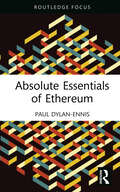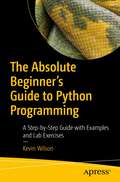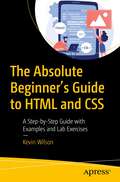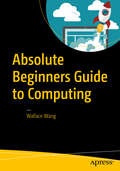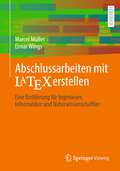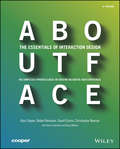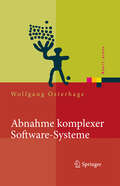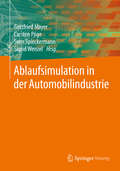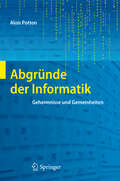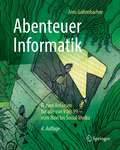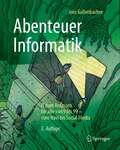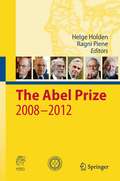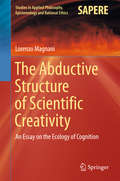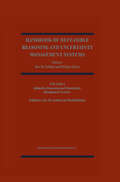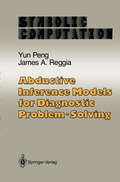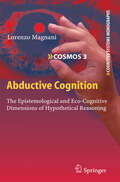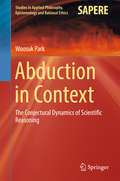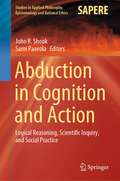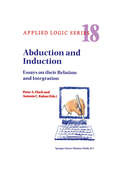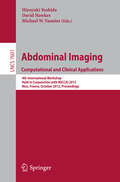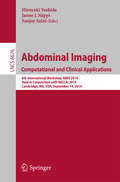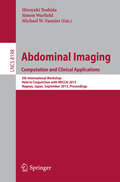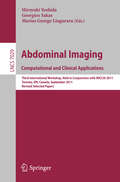- Table View
- List View
Absolute Essentials of Ethereum (Absolute Essentials of Business and Economics)
by Paul Dylan-EnnisAbsolute Essentials of Ethereum is a concise textbook which guides the reader through the fascinating world of the emerging Ethereum ecosystem, from the basics of how its blockchain works to cutting-edge applications.Written by an experienced educator, each chapter is designed to progress potential students from class to class. Technical concepts are clearly explained for those new to the topic and readers are supported with definitions and summaries in each chapter. Real-life case studies situate the overviews in a contemporary context. Topics covered include the Ethereum Execution and Consensus layers, Ethereum governance and community, Decentralised Autonomous Organisations (DAOs), Decentralised Finance (DeFi), Non-Fungible Tokens (NFTs) and Layer 2.This book is the ideal text to support undergraduate and postgraduate courses on blockchain technologies, cryptocurrencies, Web3 and fintech, as well as for those who want to know how Ethereum really works.
The Absolute Beginner's Guide to Python Programming: A Step-by-Step Guide with Examples and Lab Exercises
by Kevin WilsonWritten as an illustrated, step-by-step guide, this book will introduce you to Python with examples using the latest version of the language. You'll begin by learning to set up your Python environment. The next few chapters cover the basics of Python such as language classifications, Python language syntax, and how to write a program. Next, you will learn how to work with variables, basic data types, arithmetic, companion, and Boolean operators, followed by lab exercises. Further, the book covers flow control, using functions, and exception handling, as well as the principles of object-oriented programming and building an interface design. The last section explains how to develop a game by installing PyGame and how to use basic animation, and concludes with coverage of Python web development with web servers and Python web frameworks. The Absolute Beginners Guide to Python Programming will give you the tools, confidence, and inspiration to start writing Python programs. If you are a programmer, developer, or a student, or someone who wants to learn on their own, this book is for you.What You Will LearnGain an understanding of computer programming Understand different data and data typesWork with Classes and OOPBuild interfaces, simple games, and web development with PythonWho This Book Is ForSoftware programmers, developers or students, or anyone who wants to learn Python programming on their own.
The Absolute Beginner's Guide to HTML and CSS: A Step-by-Step Guide with Examples and Lab Exercises
by Kevin WilsonWritten as an illustrated, step-by-step guide for beginners, this book will introduce you to HTML and CSS with lab exercises and examples of code. You'll begin by setting up the development environment such as local web server and html editor. The next few chapters cover web servers, the basics of HTML such as language syntax, tags, and how to write a program. Next, you'll learn how to put together simple web pages demonstrating how the code works and how to use various HTML tags and CSS to style the pages. Finally, the use of CMS to build websites such as Drupal and WordPress and how HTML and CSS fits in. At the end there are reference libraries for both HTML tags and CSS. The Absolute Beginners Guide to HTML and CSS provides you with the tools, confidence, and inspiration to start building web pages and websites. If you are a programmer, developer or a student, or just someone who wants to learn on their own, this book is for you.What You'll LearnUnderstand basic computer programming conceptsSee how to use HTML and CSS to build web pagesApply the syntax of HTML and CSSSee how HTML and CSS fits into CMS systems such as Drupal and WordPressWho This Book Is For Software programmers, developers, students, and anyone who wants a quick reference for HTML and CSS
Absolute Beginners Guide to Computing
by Wallace WangLearn and understand how you can perform a wide range of tasks on your new Windows computer, including managing files, browsing the internet, and protecting yourself, as well as interacting with Cortana.Using Absolute Beginners Guide to Computing you will see how to use Windows, and how you can connect and communicate with others. You will learn the basics of browsing the web, how to send email, and sign up for services. You will learn about some of the social media sites such as Facebook and Twitter. You will also learn how to connect and use external hardware, and process digital music, photos, and video. Written by an author who has written multiple computing titles, this book is friendly and approachable, and can teach anyone how to use a computer. With simple steps, easy troubleshooting, and online resources, it's the best place to learn how to make computing a part of your life.What You’ll Learn:Get pictures onto your computer to shareListen to digital musicWhat clubs, groups, and other resources there are to helpWho this Book Is ForAnyone that wants to learn all the latest Windows features. Beginners who want to use their new Windows computer to share pictures or video clips on YouTube or Facebook to those seeking a common sense approach to safe computing.
Abschlussarbeiten mit LaTeX erstellen: Eine Einführung für Ingenieure, Informatiker und Naturwissenschaftler
by Marcel Müller Elmar WingsDieses Buch vermittelt die Grundlagen und das notwendige Spezialwissen, das zum Schreiben von wissenschaftlichen Abschlussarbeiten mit LaTeX erforderlich ist. Das schließt Bachelor- und Masterarbeiten sowie Dissertationen ein. Es eignet sich aber auch für die ersten Laborberichte, Studien- und Seminararbeiten.Der Leser lernt die Funktionsweise von LaTeX und diverse Werkzeuge kennen. Zur Wissensvermittlung werden Quelltextbeispiele verwendet. Übungsaufgaben und Kontrollfragen am Ende der Kapitel helfen beim Vertiefen des Erlernten. Verweise auf weiterführende Literatur und auf die jeweiligen Paketbeschreibungen unterstützen den Leser dabei, sein Wissen über den Inhalt dieses Buches hinaus zu erweitern.Das Ziel dieses Buches ist es, den Leser dahingehend zu befähigen, dass er effizient eine wissenschaftliche Abschlussarbeit in hoher typografischer Qualität mit LaTeX anfertigen kann, wenig Zeit in das Formatieren investieren muss und fokussiert am Inhalt arbeiten kann.
About Face: The Essentials of Interaction Design
by Alan Cooper Robert Reimann David Cronin Christopher NoesselThe essential interaction design guide, fully revised and updated for the mobile age About Face: The Essentials of Interaction Design, Fourth Edition is the latest update to the book that shaped and evolved the landscape of interaction design. This comprehensive guide takes the worldwide shift to smartphones and tablets into account. New information includes discussions on mobile apps, touch interfaces, screen size considerations, and more. The new full-color interior and unique layout better illustrate modern design concepts. The interaction design profession is blooming with the success of design-intensive companies, priming customers to expect "design" as a critical ingredient of marketplace success. Consumers have little tolerance for websites, apps, and devices that don't live up to their expectations, and the responding shift in business philosophy has become widespread. About Face is the book that brought interaction design out of the research labs and into the everyday lexicon, and the updated Fourth Edition continues to lead the way with ideas and methods relevant to today's design practitioners and developers. Updated information includes: Contemporary interface, interaction, and product design methods Design for mobile platforms and consumer electronics State-of-the-art interface recommendations and up-to-date examples Updated Goal-Directed Design methodology Designers and developers looking to remain relevant through the current shift in consumer technology habits will find About Face to be a comprehensive, essential resource.
About Face: The Essentials of Interaction Design
by Alan Cooper Robert Reimann David Cronin Christopher NoesselThe essential interaction design guide, fully revised and updated for the mobile age About Face: The Essentials of Interaction Design, Fourth Edition is the latest update to the book that shaped and evolved the landscape of interaction design. This comprehensive guide takes the worldwide shift to smartphones and tablets into account. New information includes discussions on mobile apps, touch interfaces, screen size considerations, and more. The new full-color interior and unique layout better illustrate modern design concepts. The interaction design profession is blooming with the success of design-intensive companies, priming customers to expect "design" as a critical ingredient of marketplace success. Consumers have little tolerance for websites, apps, and devices that don't live up to their expectations, and the responding shift in business philosophy has become widespread. About Face is the book that brought interaction design out of the research labs and into the everyday lexicon, and the updated Fourth Edition continues to lead the way with ideas and methods relevant to today's design practitioners and developers. Updated information includes: Contemporary interface, interaction, and product design methods Design for mobile platforms and consumer electronics State-of-the-art interface recommendations and up-to-date examples Updated Goal-Directed Design methodology Designers and developers looking to remain relevant through the current shift in consumer technology habits will find About Face to be a comprehensive, essential resource.
Abnahme komplexer Software-Systeme: Das Praxishandbuch (Xpert.press)
by Wolfgang W. OsterhageDas Praxisbuch dient als Grundlage für die Abnahme komplexer IT-Software-Systeme. Die behandelten Methoden gelten sowohl für Standardsoftware als auch für angepasste oder neu entwickelte Software. Der Autor beschreibt die organisatorischen Voraussetzungen und alle vorbereitenden Arbeiten für eine erfolgreiche Abnahme. Die Werkzeuge zur Durchführung und für den Abschluss werden detailliert erläutert. Berücksichtigt werden auch organisatorische Schnittstellenbereiche, die bei der Ermittlung von fachlichen und technischen Anforderungen betroffen sind.
Ablaufsimulation in der Automobilindustrie
by Gottfried Mayer Carsten Pöge Sven Spieckermann Sigrid WenzelDas vorliegende Buch stellt den Stand der Technik zur Ablaufsimulation in der deutschen Automobilindustrie zusammen und beschreibt Simulationsanwendungen in einzelnen Gewerken sowie auf Lieferkettenebene. Ferner werden Standards zur Simulation aus dem Verein Deutscher Ingenieure (VDI) und dem Verband der Automobilindustrie (VDA) aufgegriffen sowie aktuelle Entwicklungen rund um die Digitale Fabrik und Industrie 4.0 diskutiert. Autoren aus Forschung, Automobilindustrie und Automobilzulieferindustrie sowie aus Simulationsdienstleistungsunternehmen stellen Aktualität, Praxisrelevanz, wissenschaftliche und fachliche Breite sowie die Berücksichtigung unterschiedlicher Perspektiven sicher.Die ereignisdiskrete Simulation (auch Ablaufsimulation) wird in der Automobilindustrie fast durchgängig in allen Gewerken zur Untersuchung von Produktions- und Logistikprozessen eingesetzt. Mit ihrer Hilfe kann die Planung von Produktions- und Logistiksystemen umfassend abgesichert und nachvollzogen werden. Aufgrund der zunehmenden Komplexität, Flexibilität und Wandlungsfähigkeit dieser Systeme bei gleichzeitiger Verkürzung der Planungszeiträume hat sich in den letzten Jahren die Relevanz der Ablaufsimulation als Analysemethode kontinuierlich erhöht. Mit der Etablierung eines Simultaneous Engineering, der Einführung von Werkzeugen zur Digitalen Fabrik oder der Beherrschung neuer Herausforderungen im Zusammenhang mit den Bestrebungen von Industrie 4.0 unterliegt auch die Simulation neuen Entwicklungen. Das Buch wendet sich an Anwender, Forscher und Studierende in gleichem Maße.
Abgründe der Informatik: Geheimnisse und Gemeinheiten
by Alois PottonWas Sie schon immer über die Informatik und „die Informatiker“ wissen wollten, aber nie zu fragen wagten, Alois Potton hat es notiert: Über mehr als zwei Jahrzehnte hat er hinter die Kulissen geblickt und Anekdoten in 80 Glossen gegossen. Schonungslos, bösartig und zum Teil politisch nicht ganz korrekt analysiert er den alltäglichen Wahnsinn und die Absurditäten der IT-Szene. Allgemein verständlich geschrieben, werden sich auch Nichtinformatiker angesichts analoger Vorgänge in ihrem Arbeitsbereich amüsieren – oder aber beleidigt fühlen.
Abenteuer Informatik: IT zum Anfassen für alle von 9 bis 99 – vom Navi bis Social Media
by Jens GallenbacherInformatik ist der Schlüssel, um unsere zunehmend digitalisierte Welt zu verstehen! In diesem Buch lesen Sie nicht nur, wie Navis den günstigsten Weg bestimmen, wie so viele Bilder auf eine kleine Speicherkarte passen oder welche Dinge ein Computer eben nicht ausrechnen kann. Mit Papier und Bleistift und den Bastelvorlagen können Sie die Antworten auf diese und viele weitere Fragen selbst buchstäblich begreifen. Ein Computer ist dafür nicht nötig!Das Buch ist für alle da, die schon immer mal hinter die Kulissen der Wissenschaft Informatik schauen wollten: Vom Schüler zum Lehrer, vom Studenten zum Professor, vom interessierten Laien zum IT-Experten, der zwar genau weiß, wie er bestimmte Dinge zu tun hat, aber vielleicht nicht, warum sie so funktionieren oder wie er den Kern seiner tägliche Arbeit seiner Familie verständlich machen kann.Die 4. Auflage enthält nicht nur zusätzliche Kapitel, sondern stellt eine komplette Überarbeitung dar, die Jens Gallenbacher auf Basis unzähliger Erfahrungen und Rückmeldungen vorgenommen hat. Praktisch jedes Kapitel wurde ergänzt, die Bastelbögen neu gestaltet. In der neuen Auflage enthalten nun alle Kapitel durchgehend Hands-on-Anteile, damit Sie unmittelbar selbst Erfahrungen mit der Informatik sammeln können – ganz ohne Computer.Stimmen zu vorhergehenden Auflagen:„Wer mit einem Informatikstudium liebäugelt, erhält einen Vorgeschmack auf das, was ihn erwartet - alle anderen können das Buch einfach zum Vergnügen lesen.“ c't – Magazin für Computertechnik„Lassen Sie sich also ein auf das ‚Abenteuer Informatik’! Ich bin sicher, dass Sie Spaß daran haben“ LOG IN – Informatische Bildung und Computer in der Schule„Auch wenn es unglaublich klingt: Abenteuer Informatik ist ein Buch über wichtige Prinzipien der modernen informationsverarbeitenden Alltagswelt, das man beim Lesen nicht mehr aus der Hand legen will.“ BIOspektrum„Mit bester Empfehlung!" PM – Praxis der Mathematik„Bits zum Begreifen" Bild der WissenschaftProf. Dr. Jens Gallenbacher beschäftigt sich an der Technischen Universität Darmstadt sowie an der Johannes Gutenberg-Universität Mainz schon sehr lange mit der Frage, wie man die Fachwissenschaft Informatik lebendig und mit einem hohen Allgemeinbildungsgrad vermittelt. Um zu zeigen, dass Informatik mehr mit menschlicher Kreativität und konsequentem Denken zu tun hat als mit Computern, verzichtet er dabei weitgehend auf den Einsatz der Geräte. Seine Konzepte werden vom Kindergarten bis zur universitären Grundlagenausbildung eingesetzt. Fachdidaktik ist in der Lehrerausbildung sein Kernthema.
Abenteuer Informatik: IT zum Anfassen für alle von 9 bis 99 – vom Navi bis Social Media
by Jens GallenbacherInformatik ist der Schlüssel, um unsere zunehmend digitalisierte Welt zu verstehen! In diesem Buch lesen Sie nicht nur, wie Navis den günstigsten Weg bestimmen, wie so viele Bilder auf eine kleine Speicherkarte passen oder welche Dinge ein Computer eben nicht ausrechnen kann. Mit Papier und Bleistift und den Bastelvorlagen können Sie die Antworten auf diese und viele weitere Fragen selbst buchstäblich begreifen. Ein Computer ist dafür gar nicht nötig! Genau genommen sind im Buch sogar mehrere Computer aus Pappe enthalten, anhand derer man besser versteht, wie die "echten" Geräte gestaltet sind und wie diese funktionieren. Als Neuerung gibt es ergänzende, aktive Webseiten, die Sie frei (und ohne Werbung) aus dem Internet abrufen können, um mit ihnen zu experimentieren. Das Buch ist für alle da, die schon immer mal hinter die Kulissen der Wissenschaft Informatik schauen wollten: Vom Schüler zum Lehrer, vom Studenten zum Professor, vom interessierten Laien zum IT-Experten, der zwar genau weiß, wie er bestimmte Dinge zu tun hat, aber vielleicht nicht, warum sie so funktionieren oder wie er den Kern seiner tägliche Arbeit seiner Familie verständlich machen kann. Die 5. Auflage enthält zusätzliche Kapitel mit neuem Material sowie die Erweiterung und Überarbeitung der vorhandenen Kapitel. Das bewährte Hands-on-Konzept mit Experimenten und Bastelbögen zum Ausschneiden ist der durchgängige rote Faden.Stimmen zu vorhergehenden Auflagen:„Wer mit einem Informatikstudium liebäugelt, erhält einen Vorgeschmack auf das, was ihn erwartet - alle anderen können das Buch einfach zum Vergnügen lesen.“ c't – Magazin für Computertechnik„Lassen Sie sich also ein auf das ‚Abenteuer Informatik’! Ich bin sicher, dass Sie Spaß daran haben“ LOG IN – Informatische Bildung und Computer in der Schule„Auch wenn es unglaublich klingt: Abenteuer Informatik ist ein Buch über wichtige Prinzipien der modernen informationsverarbeitenden Alltagswelt, das man beim Lesen nicht mehr aus der Hand legen will.“ BIOspektrum„Mit bester Empfehlung!" PM – Praxis der Mathematik„Bits zum Begreifen" Bild der WissenschaftProf. Dr. Jens Gallenbacher liegt am Herzen, die Fachwissenschaft Informatik lebendig und mit einem hohen Allgemeinbildungsgrad zu vermitteln. Er ist an der Johannes Gutenberg-Universität in Mainz für die Ausbildung neuer Informatiklehrerinnen und -lehrer verantwortlich. Um zu zeigen, dass Informatik mehr mit menschlicher Kreativität und konsequentem Denken zu tun hat als mit Computern, verzichtet er dabei weitgehend auf den Einsatz der Geräte. Seine Konzepte werden vom Kindergarten bis zur universitären Grundlagenausbildung eingesetzt.
The Abel Prize 2008-2012 (The Abel Prize)
by Helge Holden Ragni PieneCovering the years 2008-2012, this book profiles the life and work of recent winners of the Abel Prize: · John G. Thompson and Jacques Tits, 2008· Mikhail Gromov, 2009· John T. Tate Jr., 2010· John W. Milnor, 2011· Endre Szemerédi, 2012.The profiles feature autobiographical information as well as a description of each mathematician's work. In addition, each profile contains a complete bibliography, a curriculum vitae, as well as photos — old and new. As an added feature, interviews with the Laureates are presented on an accompanying web site (http://extras.springer.com/).The book also presents a history of the Abel Prize written by the historian Kim Helsvig, and includes a facsimile of a letter from Niels Henrik Abel, which is transcribed, translated into English, and placed into historical perspective by Christian Skau.This book follows on The Abel Prize: 2003-2007, The First Five Years (Springer, 2010), which profiles the work of the first Abel Prize winners.
The Abductive Structure of Scientific Creativity: An Essay on the Ecology of Cognition (Studies in Applied Philosophy, Epistemology and Rational Ethics #37)
by Lorenzo MagnaniThis book employs a new eco-cognitive model of abduction to underline the distributed and embodied nature of scientific cognition. Its main focus is on the knowledge-enhancing virtues of abduction and on the productive role of scientific models. What are the distinctive features that define the kind of knowledge produced by science? To provide an answer to this question, the book first addresses the ideas of Aristotle, who stressed the essential inferential and distributed role of external cognitive tools and epistemic mediators in abductive cognition. This is analyzed in depth from both a naturalized logic and an ecology of cognition perspective. It is shown how the maximization of cognition, and of abducibility – two typical goals of science – are related to a number of fundamental aspects: the optimization of the eco-cognitive situatedness; the maximization of changeability for both the input and the output of the inferences involved; a high degree of information-sensitiveness; and the need to record the “past life” of abductive inferential practices. Lastly, the book explains how some impoverished epistemological niches – the result of a growing epistemic irresponsibility associated with the commodification and commercialization of science – are now seriously jeopardizing the flourishing development of human creative abduction.
Abductive Reasoning and Learning (Handbook of Defeasible Reasoning and Uncertainty Management Systems #4)
by Dov M. Gabbay Philippe SmetsThis book contains leading survey papers on the various aspects of Abduction, both logical and numerical approaches. Abduction is central to all areas of applied reasoning, including artificial intelligence, philosophy of science, machine learning, data mining and decision theory, as well as logic itself.
Abductive Reasoning: Logical Investigations into Discovery and Explanation (Synthese Library #330)
by Atocha AlisedaAbductive Reasoning: Logical Investigations into Discovery and Explanation is a much awaited original contribution to the study of abductive reasoning, providing logical foundations and a rich sample of pertinent applications. Divided into three parts on the conceptual framework, the logical foundations, and the applications, this monograph takes the reader for a comprehensive and erudite tour through the taxonomy of abductive reasoning, via the logical workings of abductive inference ending with applications pertinent to scientific explanation, empirical progress, pragmatism and belief revision.
Abductive Inference Models for Diagnostic Problem-Solving (Symbolic Computation)
by Yun Peng James A. ReggiaMaking a diagnosis when something goes wrong with a natural or m- made system can be difficult. In many fields, such as medicine or electr- ics, a long training period and apprenticeship are required to become a skilled diagnostician. During this time a novice diagnostician is asked to assimilate a large amount of knowledge about the class of systems to be diagnosed. In contrast, the novice is not really taught how to reason with this knowledge in arriving at a conclusion or a diagnosis, except perhaps implicitly through ease examples. This would seem to indicate that many of the essential aspects of diagnostic reasoning are a type of intuiti- based, common sense reasoning. More precisely, diagnostic reasoning can be classified as a type of inf- ence known as abductive reasoning or abduction. Abduction is defined to be a process of generating a plausible explanation for a given set of obs- vations or facts. Although mentioned in Aristotle's work, the study of f- mal aspects of abduction did not really start until about a century ago.
Abductive Cognition: The Epistemological and Eco-Cognitive Dimensions of Hypothetical Reasoning (Cognitive Systems Monographs #3)
by Lorenzo MagnaniAbduction in Context: The Conjectural Dynamics of Scientific Reasoning (Studies in Applied Philosophy, Epistemology and Rational Ethics #32)
by Woosuk ParkThis book offers a novel perspective on abduction. It starts by discussing the major theories of abduction, focusing on the hybrid nature of abduction as both inference and intuition. It reports on the Peircean theory of abduction and discusses the more recent Magnani concept of animal abduction, connecting them to the work of medieval philosophers. Building on Magnani's manipulative abduction, the accompanying classification of abduction, and the hybrid concept of abduction as both inference and intuition, the book examines the problem of visual perception together with the related concepts of misrepresentation and semantic information. It presents the author's views on caricature and the caricature model of science, and then extends the scope of discussion by introducing some standard issues in the philosophy of science. By discussing the concept of ad hoc hypothesis generation as enthymeme resolution, it demonstrates how ubiquitous the problem of abduction is in all the different individual scientific disciplines. This comprehensive text provides philosophers, logicians and cognitive scientists with a historical, unified and authoritative perspective on abduction.
Abduction in Cognition and Action: Logical Reasoning, Scientific Inquiry, and Social Practice (Studies in Applied Philosophy, Epistemology and Rational Ethics #59)
by John R. Shook Sami PaavolaThis book gathers together novel essays on the state-of-the-art research into the logic and practice of abduction. In many ways, abduction has become established and essential to several fields, such as logic, cognitive science, artificial intelligence, philosophy of science, and methodology. In recent years this interest in abduction’s many aspects and functions has accelerated. There are evidently several different interpretations and uses for abduction. Many fundamental questions on abduction remain open. How is abduction manifested in human cognition and intelligence? What kinds or types of abduction can be discerned? What is the role for abduction in inquiry and mathematical discovery? The chapters aim at providing answer to these and other current questions. Their contributors have been at the forefront of discussions on abduction, and offer here their updated approaches to the issues that they consider central to abduction’s contemporary relevance. The book is an essential reading for any scholar or professional keeping up with disciplines impacted by the study of abductive reasoning, and its novel development and applications in various fields.
Abduction and Induction: Essays on their Relation and Integration (Applied Logic Series #18)
by P. A. Flach Antonis HadjiantonisFrom the very beginning of their investigation of human reasoning, philosophers have identified two other forms of reasoning, besides deduction, which we now call abduction and induction. Deduction is now fairly well understood, but abduction and induction have eluded a similar level of understanding. The papers collected here address the relationship between abduction and induction and their possible integration. The approach is sometimes philosophical, sometimes that of pure logic, and some papers adopt the more task-oriented approach of AI. The book will command the attention of philosophers, logicians, AI researchers and computer scientists in general.
Abdominal Imaging -Computational and Clinical Applications: International Workshop, CCAAI 2012, Held in Conjunction with MICCAI 2012, Nice, France, October 1, 2012, Proceedings (Lecture Notes in Computer Science #7601)
by Hiroyuki Yoshida David Hawkes Michael VannierThis book constitutes the refereed proceedings of the International Workshop CCAAI 2012, held in Nice, France, in October 2012. The book includes 31 papers which were carefully reviewed and selected from 37 submissions. All of the accepted papers were revised by incorporating of the reviewers’ comments and re-submitted by the authors to be included in this proceedings volume. The papers are organized into topical sections on colon and other gastrointestinal tract; and liver, kidney, and other organs.
Abdominal Imaging. Computational and Clinical Applications: 6th International Workshop, ABDI 2014, Held in Conjunction with MICCAI 2014, Cambridge, MA, USA, September 14, 2014. (Lecture Notes in Computer Science #8676)
by Hiroyuki Yoshida Janne J. Näppi Sanjay SainiThis book constitutes the refereed proceedings of the 6th International Workshop ABDI 2014, held in conjunction with MICCAI 2014, in Cambridge, MA, USA, in September 2014. The book includes 29 papers which were carefully reviewed and selected from 33 submissions. The topics covered are liver and pancreas - ablation, perfusion, and segmentation; gastrointestinal tract - Crohn's disease; gastrointestinal tract - colonoscopy, colonography; and abdominal operation planning - registration, segmentation.
Abdominal Imaging. Computational and Clinical Applications: 5th International Workshop, Held in Conjunction with MICCAI 2013, Nagoya, Japan, September 22, 2013, Proceedings (Lecture Notes in Computer Science #8198)
by Hiroyuki Yoshida Simon Warfield Michael VannierThis book constitutes the refereed proceedings of the 5th International Workshop CCAA 2013, held in conjunction with MICCAI 2013, in Nagoya, Japan, in September 2013. The book includes 32 papers which were carefully reviewed and selected from 38 submissions. The topics covered are abdominal atlases, shape analysis and morphology in abdominal structures and organs, detection of anatomical and functional landmarks, dynamic, functional, physiologic, and anatomical abdominal imaging, registration methods for abdominal intra- and inter-patient variability, augmented reality techniques for intervention, clinical applications in radio-frequency ablation, open surgery, and minimally invasive surgery.
Abdominal Imaging: Third International Workshop, Held in Conjunction with MICCAI 2011, Toronto, Canada, September 18, 2011, Revised Selected Papers (Lecture Notes in Computer Science #7029)
by Hiroyuki Yoshida Georgios Sakas Marius George LinguraruThis book constitutes the thoroughly refereed post-conference proceedings of the Third International Workshop on Computational and Clinical Applications in Abdominal Imaging, held in conjunction with MICCAI 2011, in Toronto, Canada, on September 18, 2011. The 33 revised full papers presented were carefully reviewed and selected from 40 submissions. The papers are organized in topical sections on virtual colonoscopy and CAD, abdominal intervention, and computational abdominal anatomy.
